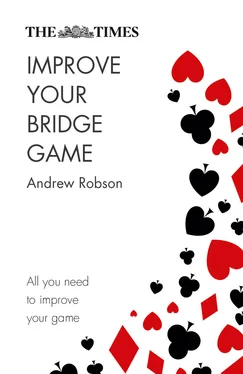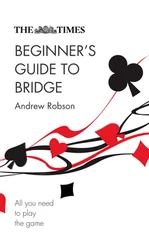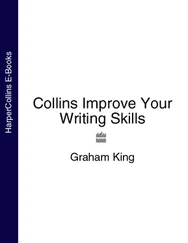The level of the response must be considered, however. Whereas a one-over-one response can be made with just six measly points, a two-over-one requires a modicum of extra strength. The partnership is already at the eight-trick level and has no guarantee of a fit. A useful guideline is The Rule of 14 (Tip 18): respond in a new suit at the two-level when your total high-card points added to the number of cards in the suit you are planning to bid gets to 14. Otherwise respond 1NT (Tip 19), the only occasion you should respond notrumps to a one-of-a-suit opener.
OVERCALLINGIf an opponent opens the bidding, you become the overcalling side. You do not need an opening hand to overcall, merely one chunky suit of at least FIVE cards (Tip 20). It is worth overcalling on relatively weak hands: even if you do not ultimately declare, you have disrupted the opposing auction and indicated a lead to partner. On the other hand, there will be some hands of opening strength that should not bid after an opponent’s opening (Tip 21), especially with no five-card suit (Tip 22).
The knowledge that partner has at least a five-card suit for an overcall means that three cards are sufficient for support (Tip 23). And the more cards you have in support, the higher you should bid – straight away (Tip 24).
Bidding 1NT as an overcall over the opponents’ one-of-suit opener, however, is more dangerous – you might be sandwiched between two strong hands. So a 1NT overcall shows a strong hand (15–19 points), more than a 1NT opener (Tip 25).
OPENER’S REBIDReturning to the opening side, arguably the most pivotal bid in an uncontested auction is opener’s rebid. It is this bid that gives much more specific information, both about shape (whether or not the hand is balanced) and strength.
A balanced opener should plan to bid/rebid notrumps (Tip 26), whereas an unbalanced opener should not (Tip 27). The three balanced distributions are 4432, 4333 and 5332 (Tip 28). With 12–14 balanced, you open 1NT; with 15–19 you open a suit and plan to rebid notrumps at the appropriate level (Tip 29), although you should in preference support with four cards in responder’s major (Tip 30). The only time you cannot make your notrump rebid is if your right-hand opponent makes a higher bid. You should then pass (Tip 31).
An unbalanced opener has three choices of rebid after responder has changed the suit: supporting responder’s suit, repeating his own suit, or trying a new suit. As usual, the top priority is support. You can use the Opener’s Support Line (Tip 32), or, in certain situations, the Losing Trick Count (Tip 33). Without support, you should try to avoid repeating your first suit with fewer than six cards (Tip 34). The only time you may have to repeat a five-card suit is when it is cheaper to do so than introduce a new four-card suit. If introducing this second suit would force responder to the three-level in order to give preference back to the first suit, you have ‘reversed’ * * NB: There is much to be said for not playing ‘reverses’. Although you will occasionally bid too high, at least you KNOW that partner has six cards when he repeats his suit (provided he opens/rebids notrumps with a 5332 shape).
and should have a decent 15 points or more (Tip 35).
When repeating a suit – implying six cards – you must remember to jump the bidding with 16+ points. Use the Opener’s Repeat Line (Tip 36). Repeating a suit does normally show six cards, so you do not need to bid it a third time to confirm your sixth card (Tip 37). But note that just because you have six cards in a suit does not mean that you have to repeat it – it is better to bid a cheaper four-card suit than repeat an anaemic six-card suit (Tip 38).
Finally, let us consider the third option for an unbalanced opener with his rebid: introducing a new suit. Although it can create awkwardness for the (mercifully rare) 4441 shape, it is sensible to assume that bidding two suits shows (at least) a five-four shape. Put another way, you should not bid a second suit with just four cards in the suit you opened (Tip 39). Normally, you bid a new suit at the lowest level. But because responder is allowed to pass the new suit rebid with an unpromising six or seven points, if you want to force the bidding to game as soon as you hear partner respond, you must jump in your second suit (Tip 40).
RESPONDER’S REBIDAfter opener has rebid, responder knows a huge amount. If opener has rebid notrumps (Tip 41), repeated his suit (Tip 42), or supported, responder knows the precise point-count and can act accordingly. Only when opener has bid a new suit does responder know less about his strength. When that happens (i.e. the first three bids are in different suits) it is responder’s job to show his strength with his rebid (Tip 43), using the Responder Line (Tip 44).
Sometimes there is no good option for responder, and a return to opener’s first suit should be regarded as preference (often on a doubleton) rather than genuine support (Tip 45). Sometimes there is more than one good option: with two fits, he should prefer the major to the minor at game level (Tip 46).
Two of the commonest mistakes here are responder forgetting to jump with 10+ points when repeating his suit (Tip 47), and forgetting that three cards in opener’s first suit make a fit (Tip 48).
DOUBLEThe literal meaning of double is to increase (by at least double) the size of penalty should the contract fail, but at the risk of increasing the opponents’ reward should the contract succeed. However, until partner has bid, you cannot really judge whether or not their contract (if a suit bid) will fail; therefore such doubles are for ‘take-out’ (Tip 49).
Double – for take-out – is one of the most useful bids in Bridge, and one of the most underused. It is a popular bid with partner too, as it asks him to describe his hand: ‘What do you think over there?’ The double of a suit opening bid shows: S hortage in the suit opened, at least O pening values, and S upport for all unbid suits (Tip 50). Assuming the next hand passes, partner must respond to the double (Tip 51). Until partner has made a positive bid, even later round doubles are for take-out (Tip 52); so if you don’t want partner to bid (because you are happy defending), don’t double (Tip 53).
If partner has made a positive bid, however, your double is for ‘penalties’. All penalty doubles express the opinion that you think the opponents are going to fail in their contract, with the accompanying increase in score. Partner will therefore generally leave in a penalty double. Because it is nonsense to be short in the suit bid when it is notrumps, the double of a 1NT opener is for ‘penalties’ (Tip 54). This – by far the most common penalty double you will encounter – will only be removed by partner when holding a hand that is both very weak and very shapely (Tip 55).
Two of the commonest mistakes in respect of the take-out double are failing to double (for take-out) after the opponents have bid two suits with four or five cards in both unbid suits (Tip 56); and failing to jump in response to partner’s take-out double with nine(+) points (Tip 57).
Perhaps the commonest mistake in the penalty double area is doubling the opponents too readily. They may then either retreat to safer havens or stay put and make the contract because you have revealed that you have good trumps (Tip 58). Better to keep quiet.
After the opponents double, you can redouble. This is an expression of confidence; but be wary of redoubling a contract you think you will make if you have reason to think the opponents might then wise up and bid on (Tip 59). Redouble is better restricted to those occasions in which an opponent has doubled partner’s opening bid and you have 10+ points (Tip 60), but no good fit (Tip 61).
Читать дальше












